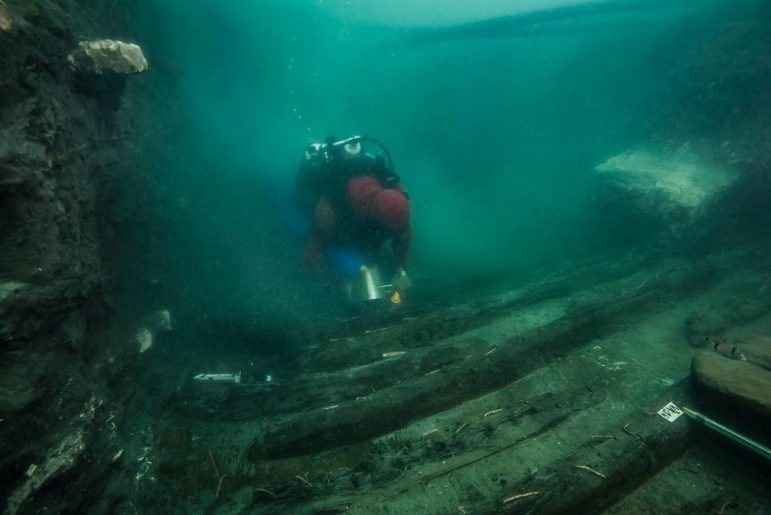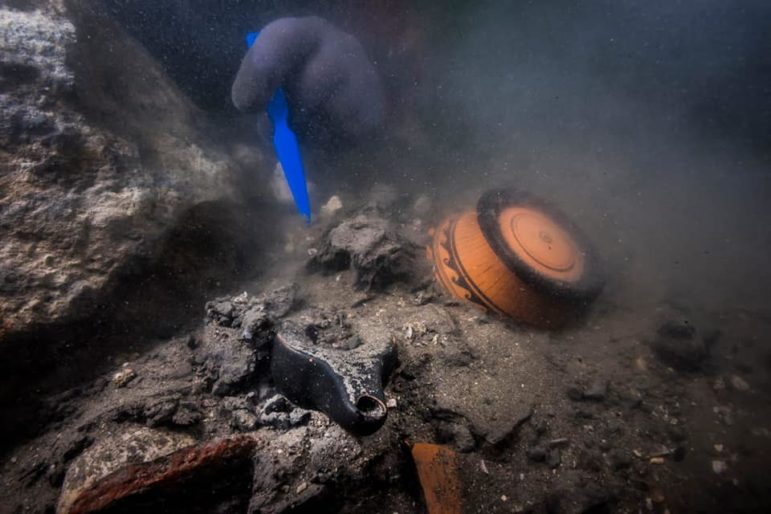ALEXANDRIA, Egypt – Divers with the European Institute for Underwater Archaeology (IEASM) have discovered two rare finds in their excavations of the ancient Egyptian port city of Thonis-Heracleion: a flat-bottomed warship and a funerary area for Greek merchants who resided in the city. Both finds are significant for telling us more about the life and culture of the city where, in the late Pharaonic period, Egyptian and Greek cultures blended together.
Thonis-Heracleion sits at the mouth of a western branch of the Nile and so had a powerful influence on trade in the region. It was eventually usurped by Alexandria, built by Alexander the Great in 331 BCE. Egyptians referred to the city as Thonis, while we know from Herodotus that the Greeks knew it as Heracleion. The city was destroyed by earthquakes and fell into the Nile, but it was rediscovered by underwater archeologists some 20 years ago and has been the subject of numerous excavations since.

A diver explores the sunken warship at Thonis-Heracleion [Egyptian Ministry of Antiquities]
The ship and funerary areas were discovered by a joint Egyptian-French team working through IEASM. The first item announced is an 80-foot long flat-bottomed ship with both oars and a sail. Artnet reports that the ship is mainly an example of classical Greek shipbuilding techniques, but includes some aspects of Egyptian crafting as well. This is only the second example of these kinds of fast ships currently known. The flat-bottom design made the ship ideal for traversing the Nile.
The ship was discovered under 15 feet of clay and debris from the nearby Temple of Amun; the temple likely took the ship with it when it collapsed in the second century B.C.E., according to Dr. Mustafa Waziri, secretary-general of Egypt’s Supreme Council of Antiquities. As the ship was pinned under blocks of stone from the temple, it is possible that the temple actually collapsed onto the ship and dragged it down below the water, where it rested for more than two thousand years.
While the ship may be the most spectacular discovery yet at Thonis-Heracleion, the funerary area may be of even greater interest. According to Professor Ehab Fahmy, director of Egypt’s Central Department of Underwater Antiquities, the funerary area dates back to the beginning of the 4th century B.C.E. Located at the entrance to the city’s northeastern canal, it shows that Greek merchants were not only allowed to settle in Thonis-Heracleion but that they built funerary temples in proximity to the great temple to Amun. This testifies to the enormous influence the Greeks wielded in the area at the time, as well as the increasing level of cultural and religious exchange between the Egyptians and the Greeks.
“This discovery beautifully illustrates the presence of the Greek merchants who lived in that city,” said the Antiquities Ministry, as reported by Reuters. “They built their own sanctuaries close to the huge temple of Amun. Those were destroyed, simultaneously and their remains are found mixed with those of the Egyptian temple.”
As with the Amun temple, the Greeks’ funerary temples were destroyed by natural disasters and eventually preserved in a deep channel seven kilometers away from the modern beach of Abu Qir. Archeologists believe the city was destroyed by the 8th century C.E.

A diver uncovering pottery at Thonis-Heracleion [Egyptian Ministry of Antiquities]
In recent years several other major discoveries have been found in the Thonis-Heracleion site. Archeology Magazine notes that the main temple to Amun contained hundreds of artifacts, including ritual tools, ceramics, and bronze coins from the reign of Ptolemy II. Meanwhile, in addition to the newly-uncovered funerary temples, archeologists have found temples to Khonsu-Herakles and Osiris. The city’s profound religious importance followed its economic importance. “The city was of prime importance to the pharaonic dynasties, which relied on it for taxes and customs duties,” according to Franck Goddio of IEASM.
As The Wild Hunt reported in 2014, another fascinating discovery from Thonis-Heracleion was a colossal head to a statue of the god of the flooding Nile, Hapi. The Hapi statue is the largest representation of the god known, indicating that his worship was especially prominent in the region.
Even after more than 20 years of continuous excavations, the lost city of Thonis-Heracleion continues to provide archeologists, historians, and modern Pagans with new discoveries that deepen our understanding of ancient Egyptian and Greek religious life. As more information comes to light about the ship and the funerary areas, we are sure to learn more about how these objects fit into the complicated cultural web of the ancient Mediterranean.
The Wild Hunt is not responsible for links to external content.
To join a conversation on this post:
Visit our The Wild Hunt subreddit! Point your favorite browser to https://www.reddit.com/r/The_Wild_Hunt_News/, then click “JOIN”. Make sure to click the bell, too, to be notified of new articles posted to our subreddit.